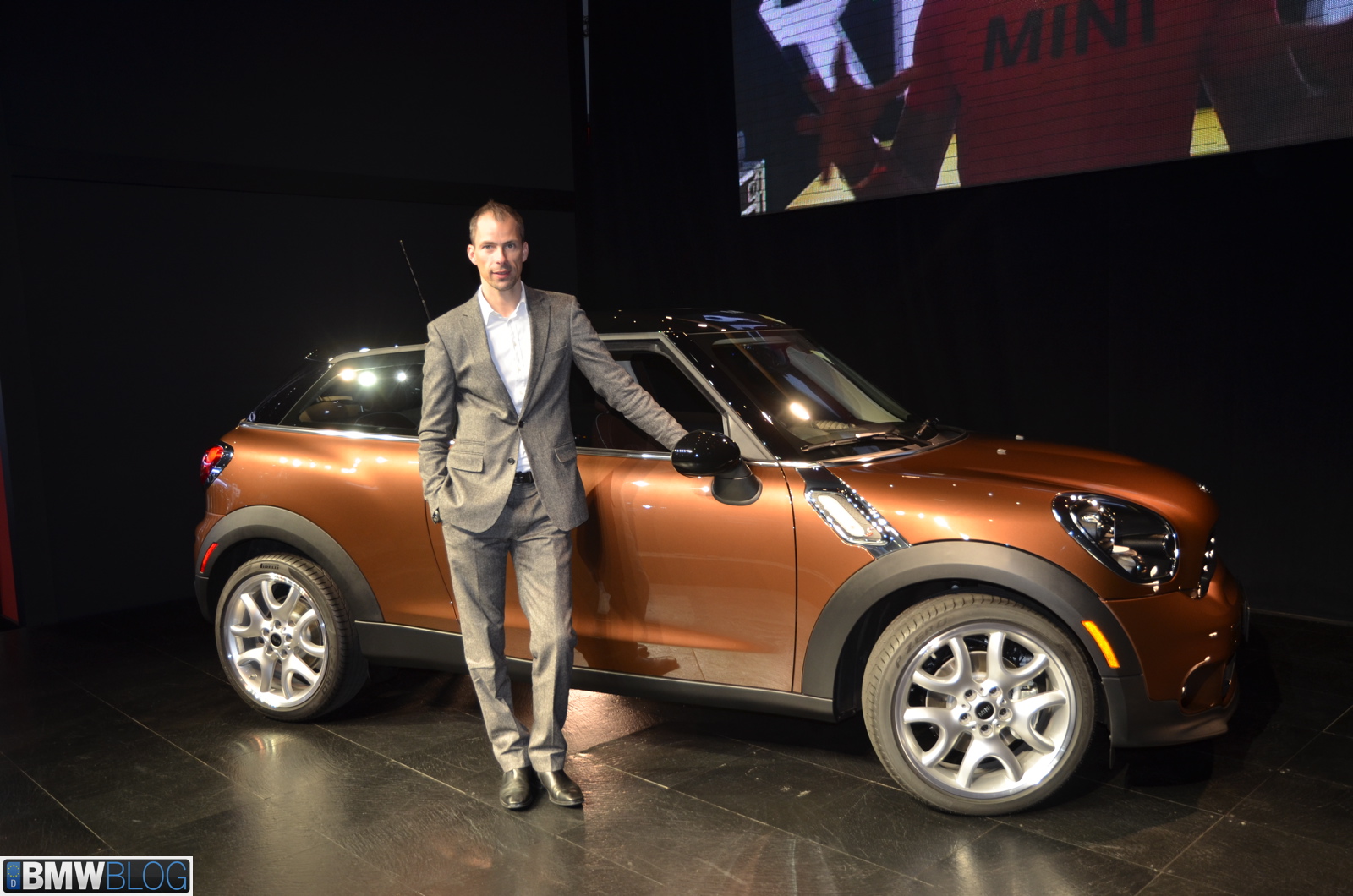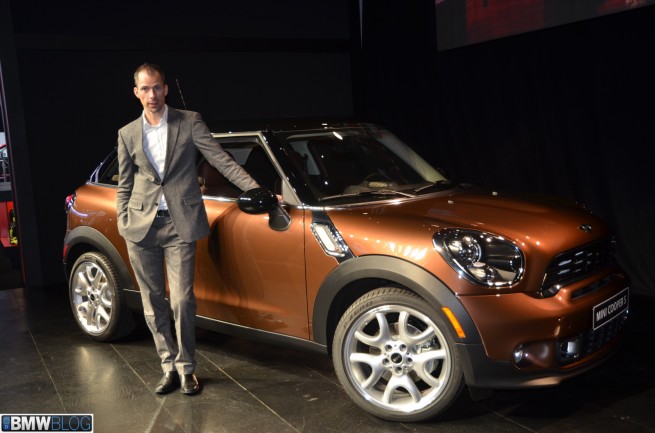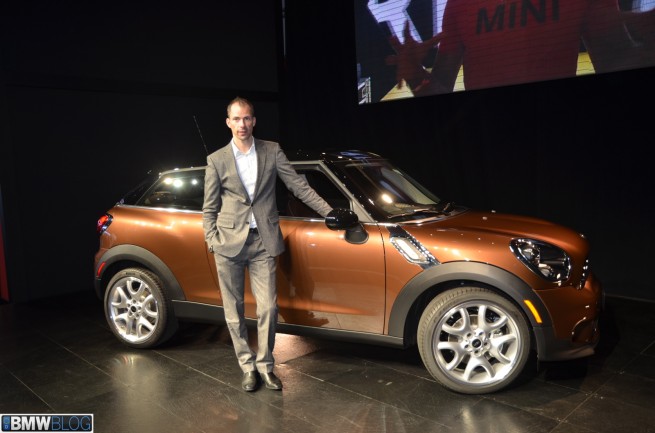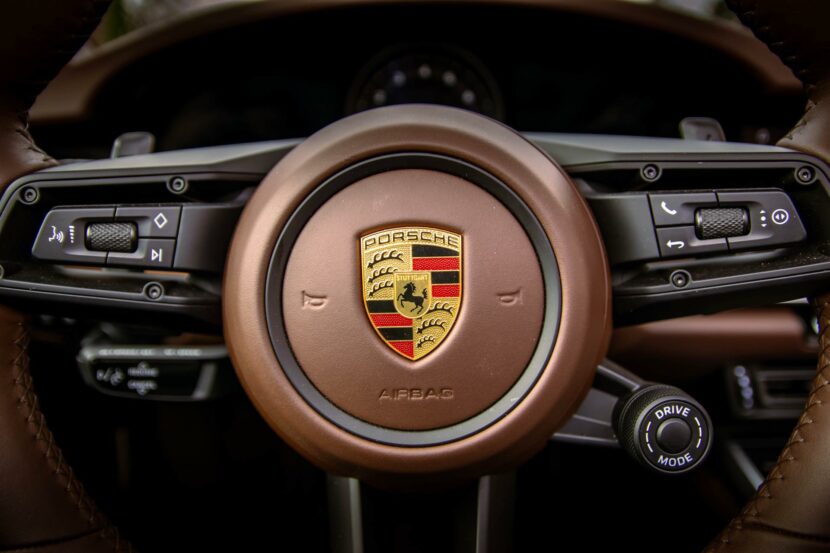At this years LA Auto Show, BMWBLOG sat down with Anders Warming, the Head of MINI Design, position he took over in December 2010. Barring a short gap, Danish-born Warming has spent his entire professional career with the BMW Group: from DesignworksUSA via BMW Design to MINI Design.
Warming’s desings are driven by engineering skill and aesthetics, intellect and gut instinct, or hand and heart. Graduate of the prestigious Art Center College of Design school, Warming designed the first generation E85 Z4 Roadster.
In his prosperous career, Warming also designed the GINA Light Concept, Mille Miglia 2006 Coupe Concept and was involved in the X1 Concept design.
In the interview below, Warming gave us some insight into the MINI design philosophy, future design languages and the future of cars in the next twenty years.
BMWBLOG: Describe for us the MINI design philosophy, now and in the future.
Anders Warming: The MINI design philosophy is for me the perfect balance of where we come from and where we’re going, meaning 50% focus on the heritage – making sure we know what the heritage of the brand is, why people love the cars, and why people have been buying the cars in the past. And 50% innovation, new ideas, materials, new technologies, new ways of customizing the cars, etc.
For me this 50-50 balance is a perfect formula: if you are focusing too much on heritage, it would take away from the innovation; the other way around, if you just innovate, a lot of fans will ask “Where is my MINI?”
So for me is the perfect balance of heritage and innovation.
BMWBLOG: Is the MINI customer changing also? Are they demanding new things from their MINIs?
Anders Warming: I think that the world of the MINI customers is changing; there is no real focus or one or the other, the car because of or the car in the context of; it’s sort of a philosophical discussion as far as the vehicle. I think that the customers are going through changes constantly and one of the things that people appreciate about MINI is that it is focused on automotive design and the automotive nature of the product, meaning that the customer will always have things that come and change, but one thing that’s staying is, I believe, a very long-term look of the MINIs. So when you look at the MINI design, I think it’s sort of back to the roots of a beautiful car, a car you can always love to fall in love with and appreciate.
BMWBLOG: What are some of the premium elements on a MINI?
Anders Warming: The premium is a combination of materials and cleverness and customization; connectivity is a big issue for us first; so it’s all these features and all these things you have in a car.
But the premium world that we’re living in has something to do with luxury, the feeling of being able to have something that is special and almost made for you. You have this idea that “MINIs were made for me”. As a customer that is also why we get a strong feedback from fans – we’re not talking about customers as much as we’re talking about fans of the brand – so in that sense that’s the premium itself, that people really have personal relationships with this car, and so every little ‘beautification’ or customization, paint, that is the relationship with the car.
There are few brands in the world where people go out in the driveway and say ‘Goodnight’ to their car, before they go to bed.
BMWBLOG: Tell us more about the MINI Paceman. What was the business decision behind that model?
Anders Warming: The decision was to look at this fantastic platform and drive-train and see what we could do with it. We were able to take what the Countryman obviously offers in the front, meaning the drive-train and windscreen and basically extended the greenhouse into a complete type of a vehicle, a car that I don’t think is just a “three-door of a five-door version” – but it’s a complete unique car, based on the drive-train of the Countryman.
That’s also why we called it Paceman, it’s an unique car, and obviously in the side view you see it the most, but I think the key view of this car is the rear view. The rear view of the Paceman is completely new to MINI, because it’s the first time that we’re introducing horizontal taillights. So far all MINis have vertical lines, now we have the horizontality which gives a new feature to the design of the MINI, because it’s something to do with the impression of width, which is something that MINI has not been looking at for a while.
The impression of width gives the car this idea of car sits really well and the wheels, looking very sporty and dynamic. And I believe it is very beautiful – and that for me is very important, as with every MINI, it has to go through a check “Is it beautiful?” “Yes”.
The horizontality is something that other brands also use, but I think that here it is done in the MINI sort of way. We are actually using the chrome surround that we have in the front, so the taillight also stretches the horizontality even more.
BMWBLOG: How true can MINI stay to its design principles, given the expansion of the brand?
Anders Warming: There is one element that will always be in the forefront and that is the issue of being the smallest car in each segment. And that is something we work on very hard, very diligently, with all our engineers, to make sure that all our overhangs are as short as they can be, that the height is as low as it can be, and it’s really about technical engineering ingenuity.
We want to make sure that the wheels are on all four corners, the car should really stand well on it wheels and should not be sort of compromised by long overhangs.
I believe that these cars – Paceman and Countryman – really have very little competitors in the marketplace, because they are much smaller; their nearest competitor are 15-20 cm longer than these cars; by that we can always say they are still the smallest cars in the segment. That is important for us.
BMWBLOG: Speaking of the next MINI design, can you tell us some words about where you are heading to?
Anders Warming: I think I’ve mentioned it in the first question as well, it goes for any new MINI that we’re working on in a daily life. You’ve seen this with the Paceman.
We want to make sure that every MINI is based on this philosophy of knowing where it comes from and having a lot of innovation. The reason why I use the word “heritage” is because heritage is got more to do with what’s in your blood veins, what’s flowing in your blood veins. And I’m not a big fan of the word “retro”, because it actually comes from the word “retrospective”, meaning you’re looking the wrong way. I like to look forward, knowing that heritage is sort of under your coat, you have to carry it, but with the element of innovation we look forward.
Innovation also means that we’re going to be focusing increasingly on issues like connectivity, because that’s part of the life that people live, and obviously we also have a big display as far as the connectivity today, but this will also be a central pillar in the future design of MINI interiors.
One thing that I always say and that is very important for me to put is that the round display in the center of the MINI is here to stay. I believe that the central display in each MINI is an icon, and this is where all our connectivity really has to have a inner stage, where people could really live their connected life through the central display.
So some of the questions that have been “Will MINI always have this round display in the middle?”, I will definitely say “Yes, confirmed”, because it’s such an important, strategic and iconic feature.
BMWBLOG: That is somehow anticipating our next question: what technical innovations will have a major influence on design?
Anders Warming: We mentioned one already: connectivity. I believe that the way we sit in the interior and the way we feel connected to the world is a huge, important thing, We also displayed that in the Concept Rocketman shown last year; that really shows what connectivity could be like, how it could be lived.
Another thing that is very important for me to the interior, as far as innovation goes, is that material quality, we focus on this premium level of materials, in order to make sure that we maintain that, and we also introduced new materials and new kinds of use and patterns that takes it to different levels.
We believe customization is in the forefront and that customization only really makes sense if you’re basing it on a certain level of quality.
The third thing I want to mention in terms of innovation is the focus on small, on light weight, making sure that the word MINImalism is part of our language. So we really have precision in the form language and we keep it as short and as focused as we can; lightweight and Minimalism is in the forefront.
BMWBLOG: How long does it take to design a car from scratch? What are the design phases?
Anders Warming: Usually we design a car in about 3 to 4 years. In this case we did it even faster, because we had a concept car at Detroit and we found out that we liked it so much, we had very positive feedback from everyone, so we turned around and did it in a very short time.
A lot of times you are basically done with the concept car and you decide that you can do it quicker, but the normal process takes about 3 to 4 years. And in that process we’re going through the normal loop of making sure that we’re asking the customers for some feedback on the kind of concepts that could be important to the world, and also if the car is already known to the market, get some customer feedback upfront.
Based on that we’re going to a design competition where obviously we – Adrian and I – present to the Board our ideas for the new projects, and the Board, based on our recommendations, will help selecting the cars.
And at some point, a year and a half or actually more than two years before production we’ll have only one car and focus on the feasibility of that car.
BMWBLOG: How do you envision cars in 10-20 years from now?
Anders Warming: That’s a good question. I think it’s got a lot to do with this design strategy I just mentioned: innovation will be in the forefront – but innovation only makes sense where it really applies to certain bloodline as far as cars go, generally.
What I don’t believe is that we will have so much innovation that you won’t recognize a car anymore. I think cars will remain cars, because it is a desirable product, as a four-wheel product with doors and steering wheel and headlights and the good stuff that we’ve loved since we were kids; obviously, being highly emotional about cars, I want to maintain the concept of cars, because it’s important to us and to the world already. But make sure that we have all the right innovations that make the car lighter, lowers the emissions, new power trains, new materials, more connectivity, all these good innovations. But in the end of the day I believe it has to be a beautiful car.
Anything can happen, but I think that the concept of a car, a beautiful product on four wheels, which makes your heart beat – from a design standpoint – will remain. I remember design assignments in school, where we were asked to design the new world, etc. and it always made me sad because I do like a lot of the stuff we have today, so I don’t want to just design a world where cars are moving around without wheels; I do think that there is a certain proportion and gesture to the car, the way the car sits and the way it fits in our life, that is important, that people keep coming back to.
Look at the reintroduction of the MINI. When MINI was introduced over 10 years ago, people found out that everything that the MINI Classic had done is applicable to today’s world. People actually said “Now I have this car, I can do this and this, but thank God it’s a beautiful car”. And it’s so funny because if you think back, before that, when people said “our new cars are not as pretty as old cars”, now we’re at the point where I believe with MINI where cross-cultural, cross-gender, cross-age, people all love the MINI. And this is something I think will remain.
BMWBLOG: Anders, thank you for your time!







































































